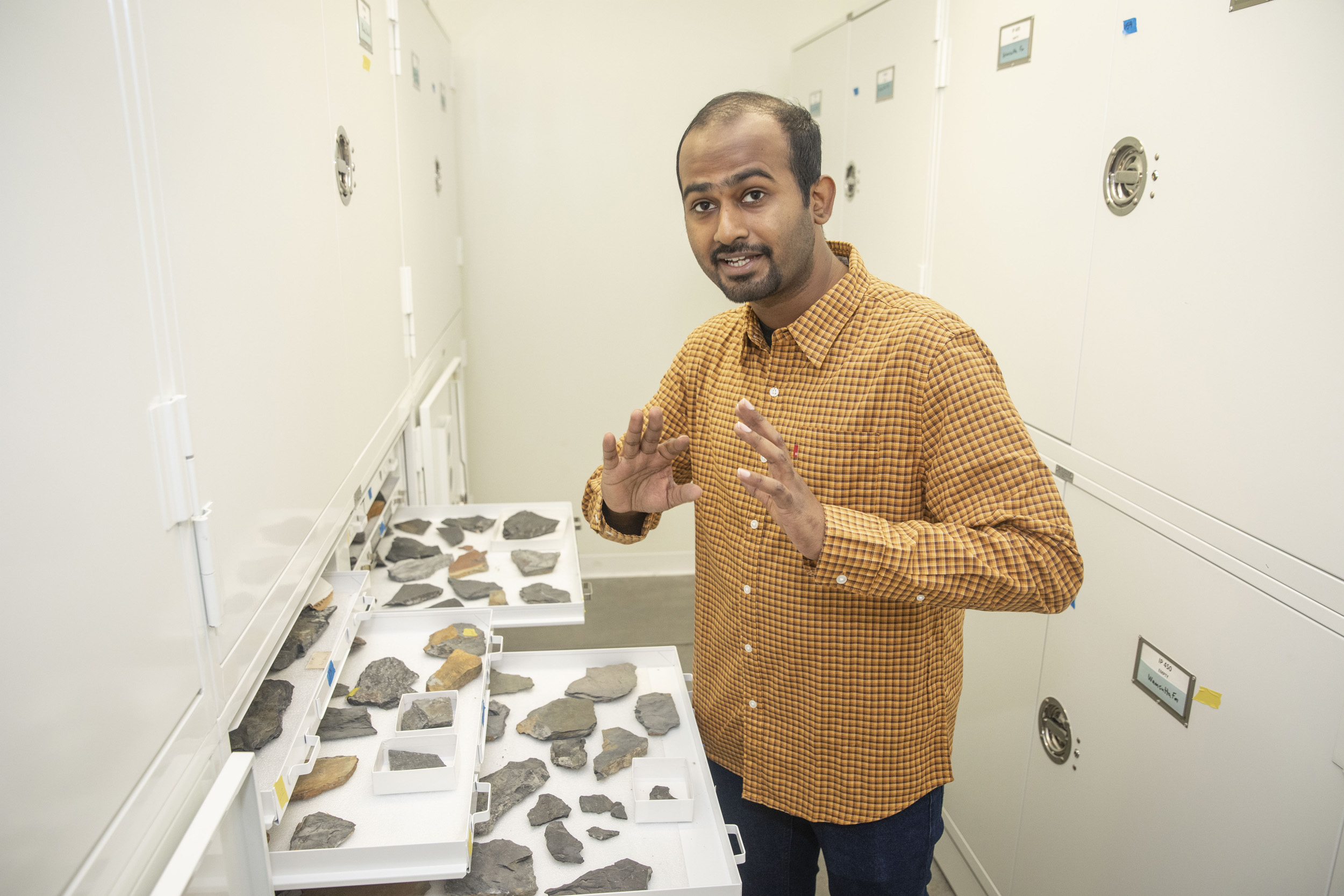
Anshuman Swain (pictured) and Adam Woodhouse examined fossil data to see how the distribution of marine plankton changed in response to bipolar ice sheets.
Kris Snibbe/Harvard Staff Photographer
Seeking clues to how shifting climate may change ocean ecosystems
New study tracks movement of marine plankton communities during Late Cenozoic cooling
Researchers know that marine organisms are shifting geographically toward the Earth’s poles in response to climate change. However, predicting the extent to which the species will move as ocean temperatures rise, and whether such changes presage a shift in ecosystems and extinction events, has not been easy to discern.
A new study published in Nature offers some possible insights. By studying the fossil record of one group of organisms, the planktonic foraminifera, researchers found communities made a global shift south to warmer waters during the Late Cenozoic period, likely driven by climatic events, specifically the development of bipolar ice sheets. The study further showed that the movement of the shell-covered, unicellular marine organisms was not tied to a coupling of functional traits and species diversity, but rather the combination of ecological and morphological traits of the organisms.
“In modern ecology we consider species diversity and functional traits synonymous,” said co-lead author Anshuman Swain, a postdoctoral researcher in the Department of Organismic and Evolutionary Biology and a junior fellow of the Society of Fellows. “But, looking back in time we found that this correlation breaks down after 2 million years, so our assumption that we can use that to predict future climate change might be misguided.”
Swain and co-lead author Adam Woodhouse, a postdoc at University of Texas at Austin, examined fossil data of Late Cenozoic planktonic foraminifera (forams), specifically the last 8 million years, to see how their relative distribution changed in response to climatic events. Rather than focus on species diversity though, they classified the data by ecological characteristics of ecogroups (where they live in the water column) and morphogroups (morphological categories of their shells).
“The trends we document are potentially worrying because if human-driven climate change suddenly switches us to an Earth of 8 million years ago [before glaciation], we may be detrimentally restructuring the marine communities of the entire ocean.”
Adam Woodhouse, study’s co-lead author
Planktonic forams float in the upper reaches of the ocean. This placing is important as the global distributions of many other organisms correlate with forams due to their low placement in the food chain. Many marine organisms (such as predatory fish, squid, krill, sharks, and cetaceans) rely on stable food chains, so how the forams respond to climate change can be a predictor for these and other organisms.
Another bonus of studying these organisms is the incomparable quality of fossil data available. The researchers applied network science methods to Triton, a global dataset of planktonic foraminiferal records with more than 500,000 individual species occurrences. The specimens were collected by the International Ocean Drilling Program from across the Earth’s oceans during more than 50 years of scientific ocean drilling. Each fossil reflects where and when the plankton lived and ocean conditions at the time.
“The fossil record of the planktonic foraminifera represents an incredible biological archive and exhibits a better Cenozoic species-level record than even the best genus-level record of any macroinvertebrate group — making them the perfect solution for our study,” said Woodhouse.
Most studies examine how species are emerging and changing. For this study, the researchers asked how the organisms (17 morphogroups and six ecogroups of forams) responded to climate change and environmental factors ecologically. “Ecogroups and morphogroups are more consistent groups throughout the Cenozoic era,” said Swain, “so they have advantages over species studies, which are inconsistent groups. This makes it easier to make predictions from traits rather than species.”
They gathered a large dataset of traits and plotted biogeographical distribution patterns in the ecogroups and morphogroups during the late Cenozoic (which started about 15 million years ago). Findings showed a global latitudinal shift toward the equator regions within clade-wide communities in both groups, especially during the past 8 million years.
“Once we saw the results, we said, ‘This is wild,’” said Swain. “Before this shift, everything was kind of random, there was no discernible strong pattern. But then, there was a strong shift that coincided with the formation of the ice sheets.”
The study showed dynamic biogeography among planktonic foraminifera, including large-scale spatial rearrangements of biodiversity patterns that appear to be coupled with the emergence of bipolar ice sheets. The expansion of polar ice caps impacted the latitudes where the ecological groups were happiest, causing them to shift due to a number of factors including where oxygen was most available. Surprisingly, this trend was not visible when looking at only species data.
“We don’t know the exact reason for this,” said Swain, “but you can have an equal abundance of species without having a sense of the different ecosystems. What we did see was that ecogroups showed this trend. Meaning this climatic event affected the distribution of foraminifera and in turn the distribution of other organisms. The foram’s correlation with anthropogenically important marine animal groups may lead us to predict more alterations to their ranges and community structure driven by ongoing climate change.”
“Earth’s current biosphere has slowly evolved over millions of years to be adapted to a world of ice ages,” Woodhouse said. “So the trends we document are potentially worrying because if human-driven climate change suddenly switches us to an Earth of 8 million years ago [before glaciation], we may be detrimentally restructuring the marine communities of the entire ocean.”




